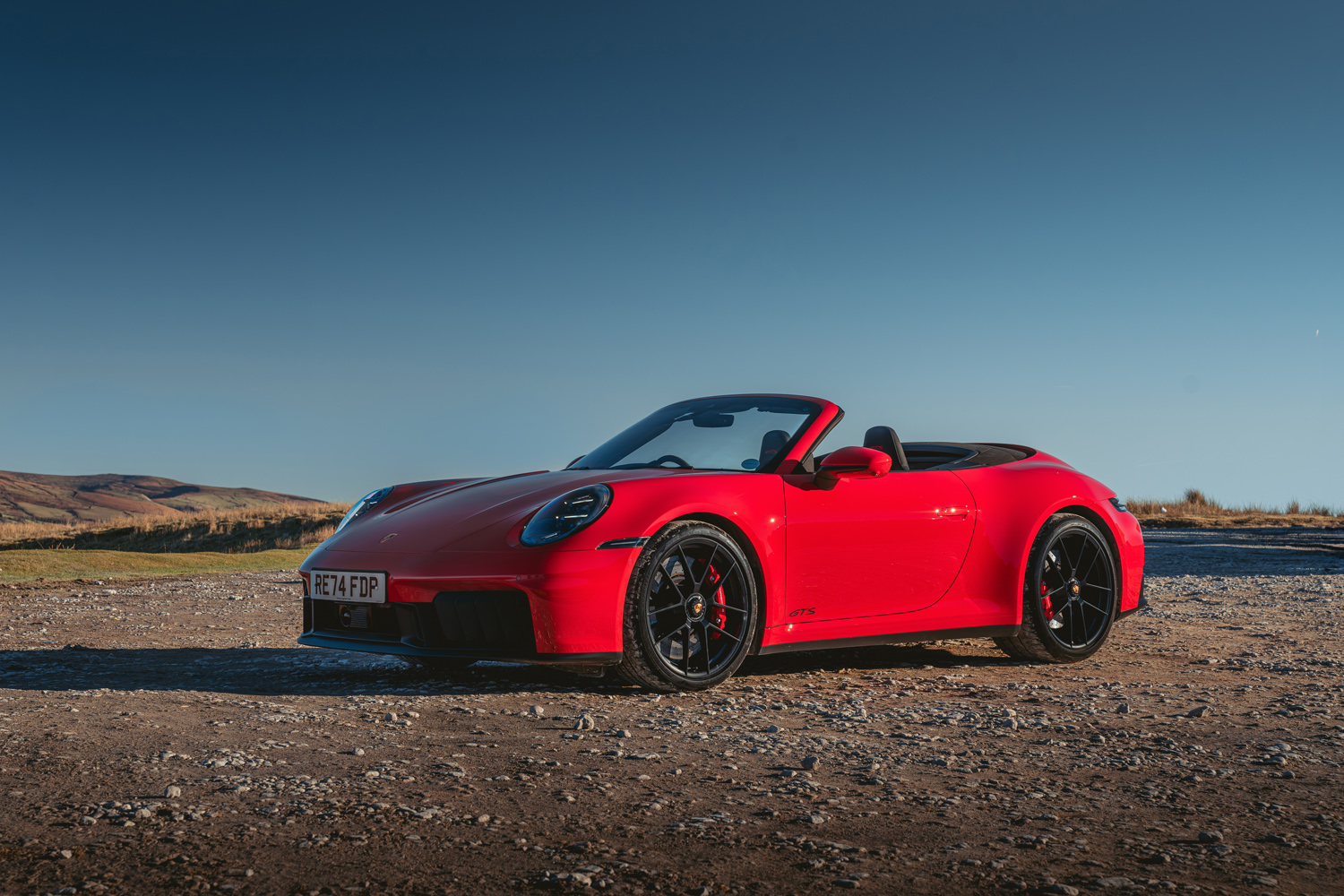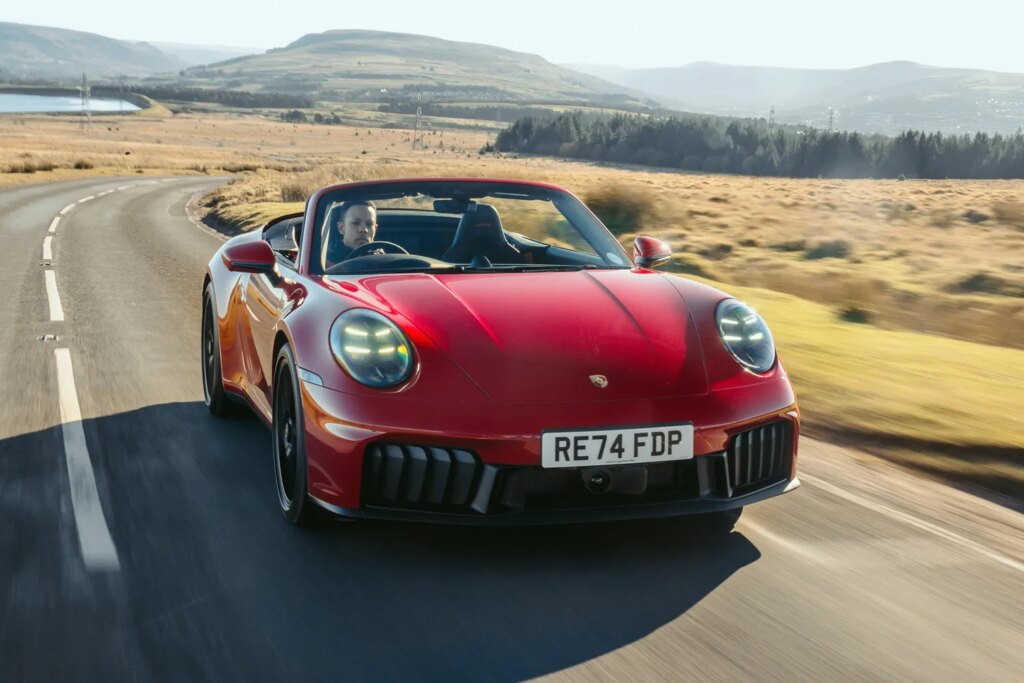Introduction
Are you one of the small portion of petrolheads that refuse to put the whole “electrification means the death of combustion” argument in the rear view mirror? Have a blast in the latest 911 GTS. Porsche’s new T-Hybrid powerplant will soon change your mind.
OK, so one of the world’s most recognisable sports cars isn’t actually ditching petrol for protons entirely just yet. Porsche’s familiar flat-six engine has instead been mated with a single turbocharger – rather than the two seen on the last-gen model – that slots an electric motor between its compressor and turbine. The resulting extra horsepower reduces turbo lag by two thirds at 2000rpm, and improves fuel efficiency to boot. Another e-motor inside the PDK gearbox lends even more assistance when you really get going. Not too shabby for a 50kg kerb weight increase.
The first electrified 911 can’t use its 1.9kWh battery for propulsion, so you’ll still need to head to the Taycan – or wait for the electric Cayman – if you want zero emissions driving. But neither have the sports car pedigree of the GTS. I spend a week with the four-wheel drive Cabriolet, which might just be the best of the bunch.
The styling: subtle evolution

The 911 silhouette is as distinctive as ever for this latest generation, albeit a larger one than it used to be. The 992.2 refresh added bolder styling front and rear, including LED Matrix headlights that neatly integrate the indicators, aero-optimised flaps in the front bumper, and an updated LED light bar on the back.
You get a few extra black trim accents on the GTS, along with model-specific black alloys – 20in front and 21in rear – that give it a purposeful stance. Then there’s the dramatic central dual-exit exhaust, influenced by Porsche’s GT division. In the right colour, this car can look properly menacing.
Yet it’s still a 911 at heart, meaning it can be used for pretty much all your driving needs. I got an infant car seat in the front, my wife in the back seat (just), and the fold-down pushchair fit in the front boot. That officially makes it a family car, dads. Clever packaging also means the extra hybrid gubbins hasn’t forced the driving position to change, so you still get the same low-slung view of the road ahead, peeking out over the iconic headlight bulges.
You can have one in coupe, cabrio, or targa bodystyles; the latter is only available with four-wheel drive, while the hard- and soft-tops have rear-driven options as well. All have a PDK automatic gearbox, necessary for the hybrid system. Arguably that makes the manual transmission Carrera T more of a driver’s car, though I’ve not driven one to confirm.
The Cabriolet’s roof retracts in twelve seconds, or more than enough to go tops-off at a set of traffic lights. If they do turn green, you’re good to keep the button held up to 31mph. There’s very little wind turbulence at 50mph, even with the wind deflector stowed.
The drive: electrifying
The GTS fires up like any combustion 911, the hybrid system preferring to lurk in the background until called upon by your right foot. Once it is, there’s an immediacy to the powertrain that you just don’t get elsewhere in the range. The turbocharger fires up almost instantly, letting the flat six put its power down with real ferocity.
That’s not to say the other cars are lethargic, or that we’ve entered EV-levels of instant acceleration; more that it makes the engine feel that bit more ready to respond to your inputs.
It takes total power to a heady 534bhp, a 60 horsepower gain over the last-gen GTS, and means the Cabriolet driven here manages the 0-62mph sprint in just 3.1 seconds. That doesn’t leave much legal room to reach the upper end of the rev range, where the exhaust note lets out an imposing roar even without reaching for the Sport setting. You get just the slightest electrical hum from the hybrid system, and even then you’ve got to really go searching for it.
While the hybrid does add extra weight, on top of that gained by optioning the convertible roof, this is still a wonderfully balanced sports car. With rear-axle steering as standard and a sublimely weighted, Alcantara-trimmed steering wheel, you’re given ample feedback and you feel properly connected with it as you make swift progress. The four-wheel drive system ensures stability as you attack corners, and propels you out of them with authority.
The ride is firm, even in the softest damper setting, but it in no way hampers the driving experience. When called for, the more dynamic modes help you feel hunkered own on the road, giving a reassuring amount of grip but keeping some rear-end playfulness accessible if you go looking for it.
The technology: preserves the lineage
It would’ve been easy for Porsche’s engineers to draw a line under the outgoing car and go all-in on tech for the 922 generation, but instead the 911 keeps one foot in the past. The 12.6in curved digital dashboard has a classic five dial view reminiscent of the 997-era car, and the Sport Chrono clock hasn’t gone anywhere.
Sure, I miss having to turn an analogue switch to fire up the engine; pressing a button isn’t quite as engaging. But the new dash is far more practical, letting you pick and choose which vital stats get shown next to the tachometer. There are plenty of physical buttons, and while the climate controls take some learning, it all falls easily within reach. I’m not entirely sold on the centre console’s high gloss finish, but materials quality is otherwise excellent.
The 10.9in central infotainment system is easy to navigate and comprehensive. It’s got all the goodies you’d expect, including wireless Android Auto – because while a significant portion of Porsche drivers are also iPhone owners, the firm isn’t leaving anyone out. Wireless Apple CarPlay is beamed onto the digital cluster. That said, there are no plans to add the dash-transforming Apple CarPlay Ultra to this generation.
Naturally the press car came fully loaded with all the toys, including a Surround View camera with active parking support (that’ll be £1298, please) and adaptive cruise control (£1468). The latter doesn’t include lane change assist as standard – if you want it, expect to spend an extra £739. The 12-speaker Bose surround sound system will set you back a substantial £1468, but it’s a box well worth ticking.
Porsche 911 GTS T-Hybrid verdict
I was never in doubt the GTS would be a corker of a 911, but was still surprised at how little it strays from the established formula, despite the extra technology – and extra weight. It’s a reassuring sign of what’s to come. It also creates a considerable gap to the regular Carrera in terms of potency, which only adds to the driver appeal.
The cabriolet wins out for me over the hard-top: it makes even short drives at pedestrian speeds an event, and doesn’t entirely sacrifice rear occupant space to achieve it. That said, in coupe form the GTS can be had with a rear spoiler that looks particularly menacing.
There’s also the small matter of the price: the most powerful non-Turbo 911 will set you back £154,400 before options, or £168,145 as tested here. On the other hand, you’re getting faster acceleration than either a McLaren GTS or Ferrari Roma, with quite a bit of change to boot. If you’re in the market for a junior supercar, this looks like an excellent addition to your shortlist.
Porsche 911 GTS T-Hybrid technical specifications
| Powertrain | 3.6-litre turbocharged flat six petrol engine |
| Battery | 1.9kW |
| Power | 534bhp |
| Torque | 450lb ft |
| 0-60mph | 3.1sec |
| Top speed | 194mph |
| Fuel economy | 25.7-26.4mpg |
| Cargo volume | 135 litres |
Read the full article here

